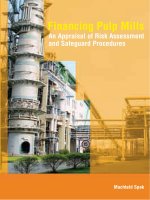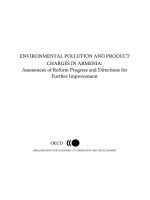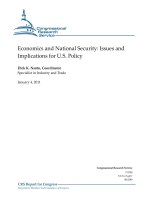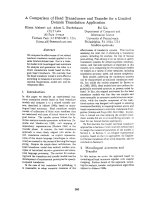House’s functional-pragmatic model of translation assessment and implications for evaluating English-Vietnamese translation quality
Bạn đang xem bản rút gọn của tài liệu. Xem và tải ngay bản đầy đủ của tài liệu tại đây (155.37 KB, 9 trang )
<span class='text_page_counter'>(1)</span><div class='page_container' data-page=1>
56
House’s functional-pragmatic model of translation assessment
and implications for evaluating English-Vietnamese
translation quality
Pham Thi Thuy*
<i> International school, Vietnam National University, Hanoi, 99 Nguy Nhu Kon Tum, Hanoi, Vietnam </i>
Received 04 September 2012
Revised 05 October 2012; accepted 24 October 2012
<b>Abstract: Translation quality assessment is not an undisputed issue in translation studies. The </b>
main problem seems to reside in how to assess the quality or what measures should be used to
evaluate the translation. The measures used will be different, depending on the purpose of the
assessment and on the theoretical framework applied to assessing the translation quality. This
paper first discusses different models of translation quality assessment (TQA). Secondly, it
describes House’s functional-pragmatic TQA model in details and applications of House’s model
combined with quantitative methods in evaluating English- German translations. Thirdly, it draws
<b>out some implications for research into assessing English-Vietnamese translations. </b>
<i>Keywords</i>: models of translation quality assessment, functional – pragmatic model, cultural filter,
register, genre, qualitative & quantitative analyses.
<i>The assessment of translator performance is </i>
<i>an activity which, despite being widespread, </i>
<i>is under-researched and under-discussed</i>.
(Hatim and Mason 1997: 199) [1]
<b>1. Introduction*</b>
In discussions about translations (as
products) and translation (as an activity) the
question of quality has always been one of top
priority. It has been repeatedly said that the aim
of each translation activity is to produce a good
translation, a good target text (TT). But what
_______
*<sub>Tel.: +84-4-35575992 </sub>
Email:
</div>
<span class='text_page_counter'>(2)</span><div class='page_container' data-page=2>
quality, and hence different ways of assessing
it’.
In this paper, firstly, I will briefly discuss
some different translation quality assessment
(TQA) models; secondly, I will describe
House’s functional-pragmatic model of
translation evaluation and applications of
House’s model combined with quantitative
methods in assessing English – German
translations; and thirdly, I will suggest some
implications for research into quality
assessment of English – Vietnamese
translations.
<b>2. Different TQA models </b>
As mentioned earlier, criteria for the
evaluation of translation depend on one’s view
of or approach to translation, and on one’s
theory of translation. There is discussion about
whether translation evaluation should take into
account the source text. Following are
non-comparative and non-comparative TQA models.
<i>2.1. Non-comparative models </i>
The representative non-comparative model
is that by Toury. His work (1978, in Maier C,
2009)[3] with translational norms suggests that
evaluative criteria be centered on the target
system alone, and he considers that translations
are facts of the target culture, their
characteristics being conditioned by target
culture forces. Although Toury argues that
comparative study might have some role in
translation criticism, he notes that comparisons
between translations and originals often lead
to “an enumeration of errors and a reverence
for the original” (Toury, 1978, in Maier C,
2009: 239).
Noncomparative models, however, do not
represent the only approach to translation
criticism; there is an insistence on the part
of some scholars that translation criticism must
take the original into account.
<i>2.2. Comparative models </i>
In what follows, I will present four
comparative models, namely Newmark’s
model, Nord’s model, Steiner’s model, and
House’s model.
<i>(i) Newmark’s TQA model </i>
Newmark’s model of criticism (Newmark,
1988: 186-8)[4] includes the analysis of the
source language text, a
comparison of it and the translation, and comm
ents about the translation’s potential role as a
translation.
The comparative study is the ‘heart’ of this
model (Newmark, ibid: 188). His
five-part model is as follows:
(1) A brief analysis of the SL text stressing
its intention and its functional aspects;
(2) The translator’s interpretation of the SL
text’s purpose, his translation method and the
translation’s likely readership;
(3) A selective but representative detailed
comparison of the translation with the original;
(4) An evaluation of the translation: a) in
the translator’s terms, b) in the critic’s terms;
and
(5) Where appropriate, and assessment of
the likely place of the translation in the target
language culture or discipline.
<i>(ii) Nord’s TQA model </i>
</div>
<span class='text_page_counter'>(3)</span><div class='page_container' data-page=3>
communicative action & proposes an analytical
model based on the function and intention
(skopos) of the target text in the target
culture.
The evaluator must take the TT skopos as
the starting point for TQA, assess the TT
against the skopos and the translator’s explicit
strategies and then do an ST/TT comparison for
inferred strategies. Nord’s model
(1991:166-167) consists of the following four steps.
(1) An analysis of the TT: the TT is
analysed in terms of intra-textual factors (such
as grammatical, lexical, and stylistic
normativity & semantic coherence) and in terms
of extra-textual factors (such as the pragmatic
dimensions of recipient, time, place, etc.)
(2) An analysis of the ST: the ST is
analysed according to the model of
translation-relevant text analysis. The critic should pay
special attention to those factors which have
been found out as ‘problematic’ during TT
assessment, such as coherence deficiencies,
inconsistent terminology, interferences in lexic
or sentence structure, etc.
(3) A comparison of the TT & the ST. This
comparison leads to a TT profile.
(4) A comparison of TT profile and the
target text: if the TT profile congruent the target
text, the translation can be regarded as
functionally adequate.
Nord emphasizes that error analysis is
insufficient: “[I]t is the text as a whole whose
function(s) and effect(s) must be regarded as
the crucial criteria for translation criticism”
(1991: 166). This is a key qualification, for on
the basis of a selection of relevant ST features;
the translator may eliminate ST items, rely
more heavily on implicatures, or “compensate”
for them in a different part of the text.
<i>(iii) E. Steiner’s TQA model </i>
E. Steiner’s approach is based on the
register theory as developed by Halliday (1964,
1978). According to Steiner E (1998, in Hoang
Van Van, 2006: 147)[6], a comprehensive
evaluation of a text should consider: the
meta-functional equivalences (the experiential,
logical, interpersonal, textual meanings & the
pragmatic meanings), and the situational
environment in which the text is embedded.
When evaluating a translation, one should
compare the target text with the source text in
terms of three register components: field, tenor,
and mode.
Field: subject matter, goal orientation,
social activities (i.e. production, exchange,
communication, reproduction, etc.)
Tenor: agentive roles, social role, social
distance (i.e. degrees of formality, degrees of
politeness), and effect.
Mode: language role, channel of discourse,
medium of discourse.
<i>(iv) House’s TQA model </i>
House (2001a:156)[7] states that in
translation criticism the assessor should always
be forced to move from a macro-analytical
focus to a micro-analytical one, from
considerations of ideology, function, genre,
register to the communicative value of
individual linguistic terms.
House’s functional-pragmatic model
consists of the following steps:
</div>
<span class='text_page_counter'>(4)</span><div class='page_container' data-page=4>
(2) The translated text is analysed along the
same dimensions and at the same level of
delicacy.
(3) The source and translation texts are
compared. An assessment of their relative
match is established: how the two texts are
similar and/or different, given differing
linguistic and cultural constraints.
Among the four comparative TQA models,
House’s model attracts the greatest attention. In
the next part, I will describe her model in
details.
<b>3. House’s TQA model combined with </b>
<b>quantitative analyses and its application into </b>
<b>assessing English-German translations </b>
<i>3.1. House’s TQA model (1977, 1997) </i>
House’s TQA model (1977, 1997) is based
on Halliday’s systemic functional theory as
well as on Prague school ideas (functional style,
functional sentence perspective, etc), speech act
theory, pragmatics, discourse analysis and
corpus-based distinctions between spoken and
written language, (House, 2001a: 134).
A Scheme for Analysing and Comparing Original and Translation Texts
(Source: House, 2001a: 139)
Following Halliday, but dismissing his
textual function as belonging to a different level
<i>of analysis, House distinguishes two basic </i>
functional components which are co-present in
every text: the ideational and the interpersonal
functional components. These two components
are to be kept equivalent in translation (House,
2006:29)[8]. By means of the different
dimensions of the model a text can be analysed
in terms of Language/ Text, Register and
Genre, as presented in the above scheme.
<b>Register covers a variety of elements, some of </b>
INDIVIDUAL TEXTUAL FUNCTION
GENRE (generic
purpose)
FIELD
Subject matter
and social action
TENOR
Participant relationship
-<i> Author’s Provenance and </i>
<i>Stance </i>
- Social Role Relationship
- Social Attitude
MODE
- <i>Medium </i>(simple/
<i>complex) </i>
- <i>Participation </i>
(simple/complex)
</div>
<span class='text_page_counter'>(5)</span><div class='page_container' data-page=5>
which are additional to those expressly stated
<b>by Halliday (Munday, 2001: 93) [9]. Field </b>
refers to the subject matter and social action and
<b>covers the specificity of lexical items. Tenor </b>
includes ‘the addresser’s temporal,
geographical and social provenance as well as
his/ her intellectual, emotional or affective
stance, i.e. his/ her ‘personal viewpoint’.
‘Social attitude’ refers to formal, neutral or
<b>informal style. Finally, mode relates to </b>
‘channel’ (spoken/ written, etc.) and the degree
of participation between writer and reader
(monologue, dialogue, etc.). The channel can be
‘simple’, i.e. ‘written to be read” or ‘complex’,
e. g. “written to be spoken as if not written”.
Participation can be “simple”, i.e. a monologue
with no addressee participation built into the
text, or “complex” with various
addressee-involving linguistic mechanisms characterizing
the text.
In addition, House’s model (2001a: 145)
focuses on register analysis of both ST and TT.
On each of the dimensions FIELD, TENOR,
MODE, she differentiates lexical, syntactic and
textual means.
- Lexical means refer to choice and patterns
of lexical items, collocations, co-occurrence,
use of onomatopoetic elements, etc. Lexical
cohesion is divided into two main categories:
reiteration and collocations
- Syntactic means include nature of the verb
phrase; mood; tenses; sentence structures:
simple, compound, or complex; repetition;
coordination or subordination; structure of noun
phrases: simple or complex with
pre-modification or post-pre-modification, etc.
- Textual means refer to textual cohesion,
which is achieved through a number of different
procedures, namely theme dynamics (or
thematic structure); clausal linkage: additive
<i>(and, in addition), adversative (but, however), </i>
etc.; iconic linkage, i.e. parallelism of
structures; repetition of redundancy words,
reference, substitution, ellipsis, etc.
House (2001a: 139-141) also distinguishes
two types of translation: overt translation and
<i>covert translation. Overt translations are source </i>
text (ST) focused. The source text is tied in a
specific manner to the source language
<i>community and its culture. Covert translations </i>
are target text (TT) focused. A covert
translation is a translation which enjoys the
status of an original source text in the target
culture. A covert translation is possible by
inserting a “cultural filter” between original and
translation with which culture-specific source
language norms are adapted to the norms
holding in the target language community.
</div>
<span class='text_page_counter'>(6)</span><div class='page_container' data-page=6>
<i>3.2. House’s recent research: qualitative & </i>
<i>quantitative analyses and the assessment of </i>
<i>English-German translations </i>
In her recent comparative analyses of texts
in English and German (House, 2001b [10];
2006), she focuses only on covert translations.
House bases her research on contrastive
discourse analyses for the language pair
German-English, which have pointed to
different communicative preferences:
-English speakers were found to give
preference to an interpersonal orientation, to
implicitness, indirectness, and the use of verbal
routines,
-German speakers show a tendency towards
a more pronounced content-orientation,
explicitness, directness, and the use of ad-hoc
formulations
The methods used in House’s research
(2001b, 2006) are as follows:
(1) Qualitative analyses: by means of
House’s translation model (1977; 1997)
(2) Quantitative analyses:
The two purposes of using quantitative
analyses provided by House are as follows: (i)
firstly, quantitative analyses serve to verify the
results of the qualitative analyses with regard to
the development of the frequency of occurrence
of certain linguistic means; and (ii) secondly,
they are designed to reveal preferred usage of
each individual form with respect to
collocations and co-occurrence as well as their
syntactic and textual position compared with
the organisation of information.
The corpus in House’s research (2006)
<i>consists of three parts: the Primary Corpus, the </i>
<i>Parallel Corpus, and the Validation Corpus. </i>
The number of texts totals approximately 550
comprising about 800,000 words. The grouping
parameters are as follows: original text or
translation, synchronic or diachronic, language
of the text, language of the original text, etc.
The corpus covers the genres such as computer
instructions, popular science texts, and external
business communication.
The corpus is used to identify language
specific, typologically-based text norms and
conventions for the genres that may be
idiosyncratic for the different cultures involved.
Furthermore, the analyses of parallel texts will
help answer the question of whether
Anglo-American text norms and conventions are found
in texts that are not translated.
The linguistic forms and phenomena which
were found in the qualitative analysis to express
subjectivity and addressee orientation in
English and German are: modal verbs,
semi-modals, modal words, particles, mental
processes, demonstrative reference (deixis),
<i>connective particles, sentence adverbials, </i>
ing-adverbials, progressive aspect, sentential mood,
complement constructions, frame-constructions,
commenting parentheses, and evaluative lexis
(House, 2006:39).
</div>
<span class='text_page_counter'>(7)</span><div class='page_container' data-page=7>
were found to be typical of English texts in this
genre.
<i>3.3. Advantages and shortcomings of House’s </i>
<i>TQA model (1977, 1997) & her recent work </i>
<i>(2006) </i>
House’s TQA model has the following
advantages. Firstly, House’s TQA model can be
applied to assessing a variety of text types:
scientific texts, commercial texts, journalistic
articles, tourist information booklets, and
fictional and non-fictional texts (House, 1977:
67)[11]. Secondly, House’s TQA model is “a
particularly good example of how the
consideration of macro- and micro-level
phenomena can be integrated, rather than
separated and opposed to each other, in
analysis,” Steiner E, (2003:17)[12]. In House’s
TQA model, ST and TT are judged on “micro
level”, i.e. lexico-grammatical features, but the
factors which allow the investigation of how
these “micro-level” features fall into relevant
configurations have to be “macro-level”, i.e.
notions such as “register” and “genre”. Besides,
macro-level categories, such as genre or
register, are not neglected, but serve an
important function both in the generation of
hypotheses, and in the interpretation of results.
On the other hand, the entire investigation is
made empirical by operationalising the
hypotheses in terms of lexico-grammatical
features, in terms of which hypotheses can be
evaluated, further developed and changed.
Thirdly, as Schäffner (1997:1) points out,
House convincingly demonstrates that her
linguistic approach to TQA includes not only
textual, situational, but also cultural aspects.
House introduces the concern towards a
scientific treatment of quality in translation. She
also revises empirical studies directed to the
reception of the translated text by the
target-culture reader, and brings to the field the used
and still very useful concept of “communicative
competence”. The pragmatic background of her
model opened a way to further studies that
incorporated cultural aspects to the
understanding of translation, Rui Rothe-Neves,
(n.d.: 114-115)[13]. Finally, other TQA models
seem less appropriate for research purposes. In
Newmark’s model the TT is compared to the
ST in order to see whether the TT is an
accurate, correct, precise, faithful, or true
reproduction of the ST. Although the
comparison involves both quantitative (i.e.
completeness of message transfer) and
qualitative aspects, (i.e. accurate ‘in denotation
and in connotation, referentially and
pragmatically’) (Newmark, 1991: 111)[14], it is
the ‘predominant assessment model in
translation teaching” (Schäffner, 1997:1). Also
Nord’s model is criticized for basing the
judgment on the nature of errors, not their
number, (Williams M, 2001: 333)[15], and
Steiner E. (in Hoang Van Van, 2006) does not
indicate the specific procedures for the assessor
to follow.
Despite the above advantages, House’s
model has been criticized for being complicated
in its categorization of grammar and for its
inflexible one-to-one matching of structure and
meaning, (Munday, 2001:101).
<b>4. Conclusion and implications for research </b>
<b>into </b> <b>assessing </b> <b>English-Vietnamese </b>
<b>translations </b>
</div>
<span class='text_page_counter'>(8)</span><div class='page_container' data-page=8>
for research purposes because i) it takes into
account both macro- and micro-level
phenomena; ii) it includes not only textual,
situational, but also cultural aspects; and iii) it
combines qualitative with quantitative analyses.
On the bases of the above concluding
remarks, the following implications can be
drawn out for the assessment of
English-Vietnamese translations. Firstly, applying
House’s TQA model, researchers can confirm
the hypotheses not only by qualitative but also
by quantitative means. Using corpora in
assessment can serve as the grounds for more
valid and reliable judgment of the translation
quality and avoid ambiguity. Secondly,
employing House’s model, translation assessors
can uncover and even prove the Vietnamese
communicative preferences expressed in
linguistic forms, i.e. culturally specific
linguistic features, as compared to those of the
Anglophone. Thirdly, House’s TQA model can
be applied to assess the translations of different
genres: from popular science texts, computer
instructions, external business communication,
to literary works.
<b>References </b>
[1] B. Hatim and I. Mason, 1997, The Translator as
Communicator, Routledge, London & New York.
[2] C. Schäffner, 1997, “From ‘Good’ to
‘Functionally Appropriate’: Assessing Translation
Quality”, Current Issues in Language & Society,
Vol. 4, No 1, (1997), 1-5.
[3] C. Maier, 2009, “Reviewing and Criticism”, in
Baker M, & Saldanha G (Eds), 2009,
Encyclopedia of Translation, 2nd ed, Routledge.
[4] P. Newmark, 1988, A Textbook of Translation,
Prentice Hall International.
[5] C. Nord, 1991, Text analysis in translation,
Rodopi, Amsterdam- Atlanta.
[6] Hoàng Văn Vân, 2006, Translation: Theory and
Practice (Dịch thuật: Lí luận và thực tiễn),
Education Publishing House, Hanoi, Vietnam.
[7] J. House, 2001a, “How do we know when a
translation is good”, in Steiner, E & Yallop, C
(eds), 2001, Exploring Translation and
Multilingual Text Production: Beyond Content,
Mouton de Gruyter, Berlin-New York, 127-160.
[8] J. House, 2006, “Covert Translation, Language
Contact, Variation and Change”, SYNAPS,
19(2006), 25-47.
[9] J. Munday, 2001, Introducing Translation Studies:
theories and applications, Routledge, NY.
[10] J. House, 2001b, “Maintenance and Convergence
in Covert Translation English-German”,
SPRIKreports, No. 15, (August 2001), 1-13.
[11] J. House, 1977, A Model for Translation Quality
Assessment, Gunter Narr Verlag:Tübingen.
[12] E. Steiner, (2003), “Macro- and Micro-level
Approaches to Translated Texts - Methodological
Contradictions or Mutually Enriching
Perspectives?”, Baumgarten, Nicole/Böttger,
Claudia/Motz, Markus/Probst, Julia (eds.),
Zeitschrift für Interkulturellen
Fremdsprachenunterricht [Online], 8(2/3), 15-19.
[13] R. Rothe-Neves, n.d., “Translation quality
assessment for research purposes: an empirical
approach”, Translation quality assessment,
113-131.
[14] P. Newmark, 1991, About Translation,
Multilingual Matters Ltd., Toronto, Sydney.
[15] M. Williams, 2001, "The Application of
</div>
<span class='text_page_counter'>(9)</span><div class='page_container' data-page=9>
Mơ hình đánh giá dịch thuật theo dụng học-chức năng của
House và đề xuất cho phê bình bản dịch Anh – Việt
Phạm Thị Thủy
<i>Khoa Quốc tế, Đại học Quốc gia Hà Nội, 99 Ngụy Như Kon Tum, Hà Nội, Việt Nam</i>
Tó<b>m tắt: Đánh giá chất lượng dịch thuật ln là vấn đề gây tranh cãi. Câu hỏi đặt ra là đánh giá </b>
chất lượng dịch thế nào hay các tiêu chí đánh giá là gì. Các tiêu chí đánh giá được sử dụng sẽ khác
nhau tùy thuộc vào mục đích đánh giá và vào khung lý luận được áp dụng cho việc đánh giá. Phần đầu
của bài viết này sẽ dành cho việc bàn thảo một số mơ hình đánh giá dịch thuật khác nhau. Trong phần
hai, bài viết sẽ mô tả chi tiết mơ hình đánh giá dịch thuật theo dụng học-chức năng của House và việc
áp dụng mơ hình này kết hợp với phương pháp định tính để đánh giá bản dịch Anh-Đức. Trong phần
ba, bài viết sẽ đưa ra một số đề xuất cho nghiên cứu đánh giá phê bình bản dịch Anh – Việt.
<i>Từ khóa</i>: mơ hình đánh giá chất lượng bản dịch, mơ hình dụng học- chức năng, bộ lọc văn hóa,
ngữ vực, kiểu loại diễn ngơn, phân tích định lượng & định tính.
</div>
<!--links-->









